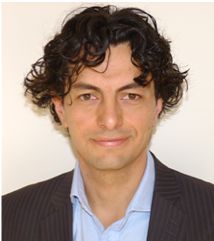ECE Seminar
Radiating systems in the near and far field for next generation wireless links: key innovations and novel paradigms
This event is free and open to the publicAdd to Google Calendar

Abstract:
Wireless links are the enabling technology for seamless connectivity and high mobility within our society. In the near future, high-speed wireless networks will benefit from the massive amount of available bandwidth in the sub- and millimeter frequency range of 5G systems and beyond, the New Space and the 6G vision of integrating terrestrial and non-terrestrial networks in a single access architecture. Future networks will handle communication between users and objects located in the far-field and near-field region of radiating devices. Antenna innovations are key to exploiting these broad bandwidths and to providing smart data links for mobile users. In collaboration with major industrial and academic partners, I recently proposed quasi-optical planar systems as efficient beam formers for multi-beam, wide-scanning antennas. Such an approach overcomes the loss and prohibitive cost associated with phased arrays at higher frequencies, while preserving the agility of the radiating unit. Implementations of the proposed system in the sub- and millimeter frequency range will be presented in different technologies such as substrate integrated waveguide (SIW), low temperature co-fired ceramic (LTCC) and silicon micromachining. For satellite links, I will show that quasi-optical planar systems can be used to drive wideband terminal antennas based on long slot arrays for wide field of views. In particular, I will introduce an ultra-robust assembly method for multi-layer structures in low-cost printed circuit board (PCB) technology. This key innovation – which ensures electrical contact and low-loss propagation among stacked layers by means of capacitive fingers – enables the implementation of complex radiating structures at millimeter waves. In addition to these efforts on far-field radiating systems, I will summarize my current studies on non-diffractive beams in the radiative near field. In particular, I will show how non-diffractive beams can be generated with planar radiating structures such as metasurfaces and radial line slot arrays with various field polarizations and bandwidths through the excitation of cylindrical leaky waves. The generation of X-waves (non-diffracting pulses) will also be discussed. A wideband circularly polarized radial line slot array will be introduced that can generate X-waves at millimeter waves. The capability of non-diffractive beams to defeat the path loss and overcome obstructions will be introduced. A non-diffractive link made by two spline-profiled horn antennas generating Bessel beams at millimeter frequencies will be presented to show the resilience of non-diffractive links to obstructions. This experimental validation paves the way to a novel paradigm for next generation near-field wireless links.
Biography:
Dr. Mauro Ettorre received a Laurea degree “summa cum laude” in Electrical Engineering and a Ph.D. in Electromagnetics from the University of Siena, Italy, in 2004 and 2008, respectively. Part of his Ph.D. work was developed at the Netherlands Organisation for Applied Scientific Research (TNO), The Netherlands, where he later worked as an Antenna Researcher. From 2008 to 2010, Dr. Ettorre was a Postdoctoral Fellow at the IETR, University of Rennes 1, France. In October 2010, he joined IETR as a CNRS Research Scientist. In 2010 and 2016, he was a Visiting Scholar in the Radiation Laboratory, University of Michigan, Ann Arbor, USA. In 2015, he was an invited professor at Tokyo Institute of Technology, Japan. From 2014 until 2020, he led the multi-beam antenna activities for satellite applications in the joint laboratory (MERLIN) between IETR and Thales Alenia Space, France. From 2016 until 2021, he was the scientific secretary of the French National Committee for Scientific Research, Section 08 (micro- and nanotechnologies, photonics, electromagnetism), CNRS, Paris, France. From 2016 until 2021, he led the BEAMS (BEam Antennas up to Mm and Sub-mm waves) team at IETR. Since 2021, he is co-chairing the department ADH (Antennas and Microwave Devices Department) at IETR. Dr. Ettorre’s research interests include the analysis and design of millimeter and sub-millimeter antennas, periodic and quasi-periodic structures, quasi-optical systems and beam formers, near-field focusing devices and non-diffractive waves.
He has authored over 73 journal papers, 176 conference communications and holds 13 patents on millimeter-wave antenna technology. Dr. Ettorre is a senior member of IEEE. Since 2017, he is an Associate Editor of the IEEE Transactions on Antennas and Propagation. From 2017 until 2020 he was a member of the Selection Committee for the Best Paper Award, IEEE Transactions on Terahertz Science and Technology. In 2019, he co-founded the open access journal Reviews on Electromagnetics of EurAAP for which he serves as Associate Editor. In 2020 and 2021 he was appointed European Association on Antennas and Propagation (EurAAP) ambassador. Since 2021, he is member of the technical committee MTT-29 Microwave Aerospace Systems.
Dr. Ettorre was the recipient of the 2009 French Ministry of Research award for the most innovative project in all natural sciences, the 2012 Starting Grant Award from the city of Rennes, France, the Young Investigator Grant from the French National Research Agency in 2014, the 2016 and 2020 CNRS Award for scientific excellence. The research activities of Dr. Ettorre have been recognized with several prizes, including the Innovation Award at the 2018 ESA Antenna Workshop in the Netherlands, the Best Paper Award in Electromagnetics and Antenna Theory at the 2018 European Conference on Antennas and Propagation (EuCAP), London, UK and the Best Antennas Paper Award at EuCAP 2021, Düsseldorf, Germany.
 MENU
MENU 
